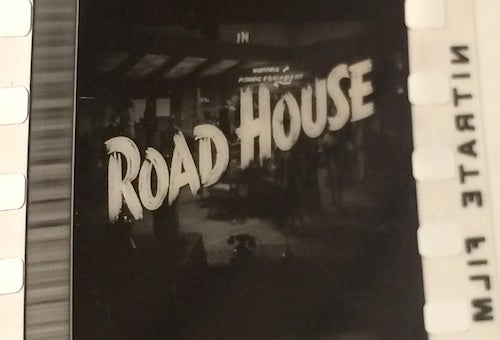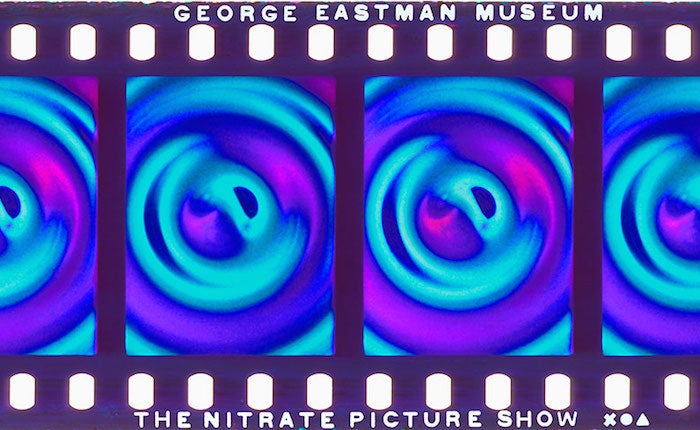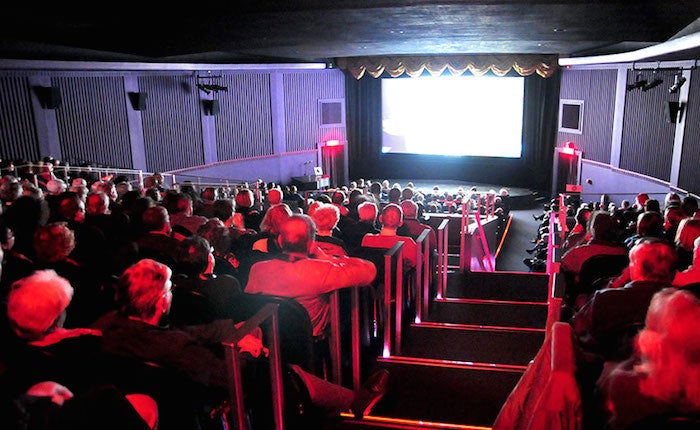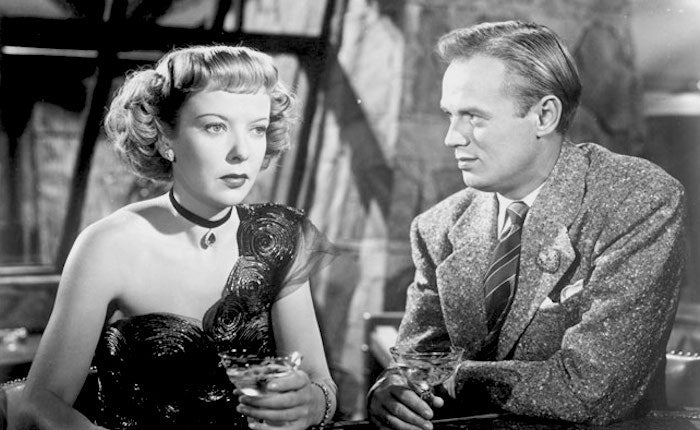
Nitrate film print of Road House (1948)
From April 29 to May 1, several hundred film archivists, historians, and cinephiles gathered at Eastman Museum for the 2nd annual Nitrate Picture Show. Senior Curator Paolo Cherchi Usai had the brilliant idea to stage the weekend program in conjunction with the 20th anniversary of the L. Jeffrey Selznick School of Film Preservation and the retirement party of Associate Curator Edward Stratmann, guaranteeing full houses for almost all the screenings.
Going to Rochester is always brings mixed emotions, since I spent 12 years working at Eastman. My own personal reason for making the trek was that I wanted to honor Ed, who I originally promoted to his curatorial position. Ed and I have known each other for 41 years, as I noted at the retirement lunch on Friday afternoon, since I had been a post-graduate intern at Eastman in the Film Department in the mid-1970s. Ed was working for the Museum’s facilities manager and projecting film on occasion. 12 years later, after I had returned to Eastman, I asked Ed to become our preservation officer. After the founding of the Selznick School under Paolo Cherchi Usai, Ed Stratmann became the instructor of record for the school and was lionized by the students. That became clear during the lunch, which was attended by more than 100 alumni.
The L. Jeffrey Selznick School of Film Preservation was established by Jeffrey Selznick and Paolo Cherchi Usai in 1996. Since then, the school has graduated more than 180 archivists from 21 countries in their one-year certificate and two-year masters program. Many of today’s younger generation of prominent moving image archivists received their training in Rochester, including Liz Coffey, Brian Graney, Andrew Lampert, Regina Longo, Brian Meacham, Albert Steg, Dwight Swanson and Katie Trainor. As noted on the school’s website: “The staff and alumni of the Selznick School lead the way in studying the conservation challenges of the moving image and audio visual formats of the past and present, and in preparing students to meet those of the future.”

Image credit: Eastman Museum
Friday afternoon also witnessed two lectures in the “Keepers of the Frame” series, by David Francis, former Director of the National Film Archive in London and Chief of the Library of Congress Motion Picture Division, and Wolfgang Klaue, former Director of the Staatliches Filmarchiv der DDR, and former Secretary General of FIAF. While Francis talked about his efforts to convince the British government to build new nitrate vaults, Klaue talked about his difficult work, trying to build up the film archive in the face of resistance from East German Communist Party bureaucrats. Francis organized the storied 1978 FIAF Congress in Brighton, which was my first FIAF contact, and Wolfgang has been a longtime supporter of my work, going back to when I was a graduate student in the early-1980s. I was therefore particularly happy to have time to chat with both of these early influences on my career.

Eastman Museum's Dryden Theatre. Image credit: Eastman Museum.
As was the case for the Nitrate Picture Show's first iteration in 2015, the program was not made public until participants arrived in Rochester. That such a program of nitrate prints should develop in Rochester makes sense, given Paolo Cherchi Usai’s advocacy in the film archive community of treating surviving nitrate prints like unique museum objects with intrinsic artistic value, as discussed in his book Film Curatorship. Like fine wine, they should be aired periodically, and screened carefully, but consistently, as long as the material warrants it. For anyone interested, I reviewed Film Curatorship here. Thus, there was talk before every screening about the level of shrinkage of individual prints, allowing them to be screened or not.

Road House (1948)
The festival finally got started on Friday late afternoon with a nitrate shorts program from various archives, including Christopher Young’s seldom seen experimental film, Object Lesson (1941). I stayed for an original print of Enamorada (dir. Emilio Fernández, 1946) from the Televisa Foundation, which UCLA is planning to preserve from the original camera negatives. The next day, I caught the Library of Congress’ Technicolor IB print of Annie Get Your Gun (dir. George Sidney, 1950), whose Native American content made me cringe; the BFI’s Brighton Rock (dir. John Boulting, 1947), a great British film noir with a young Richard Attenborough as a psycho-killer; and Eastman Museum’s Ladri di Biciclette (Vittorio de Sica, 1948), which I screened in my very first film series at Eastman House in 1985. Finally, on Sunday morning, I introduced UCLA’s print of Road House (Jean Negulesco, 1948), another film noir, this one starring Ida Lupino as a down-and-out torch singer. Except for the Annie print, all the prints we viewed were in fabulous condition and were certainly appreciated by the many audience members who don’t often have an opportunity to see nitrate film. Indeed the weekend was so successful that next year’s nitrate weekend in Rochester has already been announced.
< Back to Archival Spaces blog






 Mobile Navigation
Mobile Navigation

